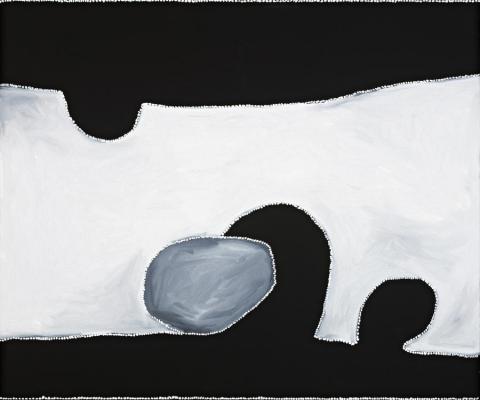MENDOOWOORRJI - MEDICINE POCKET, 2006
PADDY NYUNKUNY BEDFORD
natural earth pigments with synthetic binder on linen
150.0 x 180.0 cm
inscribed verso: artist's name, title and Jirrawun Aboriginal Arts cat. PB 3 2006.245
Jirrawun Aboriginal Arts Corporation, Kununurra
The K.D.H. Ainsworth Collection, Queensland
Paddy Bedford, Museum of Contemporary Art, Sydney, 6 December 2006 - 15 April 2007; Art Gallery of Western Australia, Perth, 12 May - 22 July 2007; Bendigo Art Gallery, Victoria, 11 August - 16 September 2007, University of Queensland Art Museum, Brisbane, 16 November 2007 - 2 March 2008
Storer, R., Paddy Bedford, Museum of Contemporary Art, Sydney, 2006, pp. 113, 158 (illus.)
Mendoowoorrji refers to the stretch of hills between Thoonbi and Thoowoonggoonarrin, to the south-east of Bedford Downs. This land belongs to the artist's mother's dreaming. Medicine Pocket was an important camping area pre-colonisation because of its 'living water'. This region is replete with brooks and waterways flowing through open land and bordered by hills. Like so much of his work, our painting conveys Bedford's intricate knowledge of his country, its features, topography, and sacred narratives.
While Bedford's earlier work engaged the use of natural ochres and multiple colours, his later work employed a more restrained and pared-back palette, often using only black and white (and sometimes grey) to depict his environment. Painted in the year before his death, Mendoowoorrji evokes the cosmic skies and sparse outlines of the Kimberley landscape. Here the awkward shapes of rocks and other curious landforms are composed on a vast backdrop. There is a careful balancing act that finds some measure of harmony between these elements.
The addition of white dotting contributes another level of aesthetic dynamism to this already powerful image. Seemingly omnipresent in East Kimberley painting, Bedford rhythmically applies these dots, retracing the contours of his landscape with vivid white. The stippling not only adds detail to an otherwise mute and unembellished composition, it also provides depth and vibrancy to the flatness of the image. 'Viewed from a distance, the perfunctory irregularity of stippling produces a luminous vibration that dematerialises the opacity of the surface.'1
1. Dolk, M., 'Are we Strangers in this Place', in Storer, R., Paddy Bedford, Museum of Contemporary Art, Sydney, 2006, p. 37
LEAH CROSSMAN
